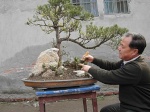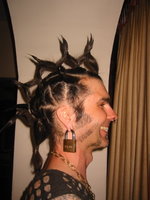clip bonsai tree root
+2
Rob Kempinski
beijing
6 posters
Page 1 of 1
 clip bonsai tree root
clip bonsai tree root
clip bonsai tree root
The external shape of the roots of bonsai is very important works in miniature external root
j is determined by the performance of the works of high, and even is the key to success.
Material of most trees can not be perfect, the roots, the total existence of defects in
one way or another. I adopted the practice for many years, ¨ I think the majority of
defects can be after three to five years or more improvement and growth, get a better repair
of the defects in the original treatment has been a step-by-step as long as the
identification of transcripts and the eradication of beauty and ugliness, grasp the key
points. Methodologically sound, and all are expected. This is what this article to talk
about the rationale for the root of the Bonsai technique.
To the rationale for the root, we must increase the root's ability to appreciate
beauty, to find out what kind of shape was the best roots, the roots of what is not
beautiful, and what kind of roots of the taboo is ugly.







welcome to my BeiJing Bonsai
Source:http://www.beijingbonsai.com/Bonsai-Teach/bonsai-977.html
The external shape of the roots of bonsai is very important works in miniature external root
j is determined by the performance of the works of high, and even is the key to success.
Material of most trees can not be perfect, the roots, the total existence of defects in
one way or another. I adopted the practice for many years, ¨ I think the majority of
defects can be after three to five years or more improvement and growth, get a better repair
of the defects in the original treatment has been a step-by-step as long as the
identification of transcripts and the eradication of beauty and ugliness, grasp the key
points. Methodologically sound, and all are expected. This is what this article to talk
about the rationale for the root of the Bonsai technique.
To the rationale for the root, we must increase the root's ability to appreciate
beauty, to find out what kind of shape was the best roots, the roots of what is not
beautiful, and what kind of roots of the taboo is ugly.







welcome to my BeiJing Bonsai
Source:http://www.beijingbonsai.com/Bonsai-Teach/bonsai-977.html

beijing- Member
 Re: clip bonsai tree root
Re: clip bonsai tree root
Good point made very well. Worth book marking.
Roots usually take the longest to fix on a tree design.
Roots usually take the longest to fix on a tree design.

Rob Kempinski- Member
 Re: clip bonsai tree root
Re: clip bonsai tree root
The label bad is ok but good should be "Oh my Lord this is fantastic!!"
ciao...Leonardo
ciao...Leonardo
leonardo- Member
 Re: clip bonsai tree root
Re: clip bonsai tree root
I think I get the general idea of what Beijing is saying, but could someone please post a better translation? I'd like to make sure I understand this topic properly.

Harleyrider- Member
 Re: clip bonsai tree root
Re: clip bonsai tree root
As part of my Moderator's duties, I have been appointed (okay I volunteered) as official "translator" so in accordance with Harleyrider's request here is a loose translation of what Beijing is saying:
Transcript begins:
Pruning and Shaping Bonsai Roots
The external shape of the roots of bonsai is very important. (I will use the term nebari from now on to show we are talking about the visible part of the root system – Mod)
Trees may not always be perfect, and the existence of nebari defects of one sort or another is common.
I think the majority of nebari problems can be improved over a period of about three years or more, both by the natural growth process and adopting good practices to remedy faults.
But to achieve the best improvement, it is necessary first to understand the basic principles of what makes the nebari good. That way you can eradicate the bad factors and concentrate on improving the good points. Once you understand the basic principles of what makes good nebari you then have to be methodical in how you approach your improvements. In this article I want to talk about the rationale behind achieving good nebari in bonsai.
As part of this rationale we will identify why good nebari is important to the overall beauty of the tree, what makes for good nebari, what is not good and what is downright unsightly.
Transcript ends:
I think the picture section is completely self-explanatory (and also very useful!)
Please bear in mind that I do not speak the poster's own language nor have I seen the original language version, so what I have put here is a loose translation as I said earlier. Can I cordially ask people not to hijack this post with discussions of the semantics of how I've translated the post - it is only meant as a guide. Let's look at the discussion points Beijing raises because as Rob rightly says there is some extremely valuable stuff therein.
I am now looking at ways we can help non-English speakers to post without reliance on translators such as babelfish which are notoriously inaccurate. If anyone is prepared to help a fellow countryman translate from their native tongue into English then I'm happy to co-ordinate such a service.
Not sure how we'll cope with translating from Scouse into English though!
Please bear in mind
Transcript begins:
Pruning and Shaping Bonsai Roots
The external shape of the roots of bonsai is very important. (I will use the term nebari from now on to show we are talking about the visible part of the root system – Mod)
Trees may not always be perfect, and the existence of nebari defects of one sort or another is common.
I think the majority of nebari problems can be improved over a period of about three years or more, both by the natural growth process and adopting good practices to remedy faults.
But to achieve the best improvement, it is necessary first to understand the basic principles of what makes the nebari good. That way you can eradicate the bad factors and concentrate on improving the good points. Once you understand the basic principles of what makes good nebari you then have to be methodical in how you approach your improvements. In this article I want to talk about the rationale behind achieving good nebari in bonsai.
As part of this rationale we will identify why good nebari is important to the overall beauty of the tree, what makes for good nebari, what is not good and what is downright unsightly.
Transcript ends:
I think the picture section is completely self-explanatory (and also very useful!)
Please bear in mind that I do not speak the poster's own language nor have I seen the original language version, so what I have put here is a loose translation as I said earlier. Can I cordially ask people not to hijack this post with discussions of the semantics of how I've translated the post - it is only meant as a guide. Let's look at the discussion points Beijing raises because as Rob rightly says there is some extremely valuable stuff therein.
I am now looking at ways we can help non-English speakers to post without reliance on translators such as babelfish which are notoriously inaccurate. If anyone is prepared to help a fellow countryman translate from their native tongue into English then I'm happy to co-ordinate such a service.
Not sure how we'll cope with translating from Scouse into English though!
Please bear in mind

fiona- Member
 Re: clip bonsai tree root
Re: clip bonsai tree root
Thanks for that Fiona, much appreciated. It was pretty much what I thought it was, but you added a few important details I missed.
Interesting and usefulpost, Beijing. Thanks.
Interesting and usefulpost, Beijing. Thanks.

Harleyrider- Member
 Re: clip bonsai tree root
Re: clip bonsai tree root
According to Beijing, overlapping roots are undesirable. I've seen plenty of trees with a tangle, or network, of roots which, to my eyes at least, looked very natural and suited the tree well. What do you think?

Harleyrider- Member
 Re: clip bonsai tree root
Re: clip bonsai tree root
fionnghal wrote:
Not sure how we'll cope with translating from Scouse into English though!
Cum 'ed den?
Guest- Guest
 Re: clip bonsai tree root
Re: clip bonsai tree root
I would now love a tutorial in some of the ways of achieving a good nebari and rectifying a bad one.

Smithy- Member
 Re: clip bonsai tree root
Re: clip bonsai tree root
I am perfectly calm, thank you! And in return, may I offer you the traditional Glasgow response: awa'anbileyertottieyabigeejitye!Tony wrote: Cum 'ed den?
I hope Beijing will be giving us further installments. The link on his post just took you to the same article and I didn't have much chance to see if he had any follow-ups there. So, Beijing, do feel free to give us all some more on this topic.Smithy wrote: I would now love a tutorial in some of the ways of achieving a good nebari and rectifying a bad one

fiona- Member
 Similar topics
Similar topics» Common ash Fraxinus Excelsior - clip and grow tree
» clip & gro, clip & gro jan 2011 - jan 2014
» Root Aphids and Bonsai
» Is it Possible to Grow a Bonsai from a Root Cutting
» new project !!! the pot for..." Root Over Rock Bonsai "
» clip & gro, clip & gro jan 2011 - jan 2014
» Root Aphids and Bonsai
» Is it Possible to Grow a Bonsai from a Root Cutting
» new project !!! the pot for..." Root Over Rock Bonsai "
Page 1 of 1
Permissions in this forum:
You cannot reply to topics in this forum






